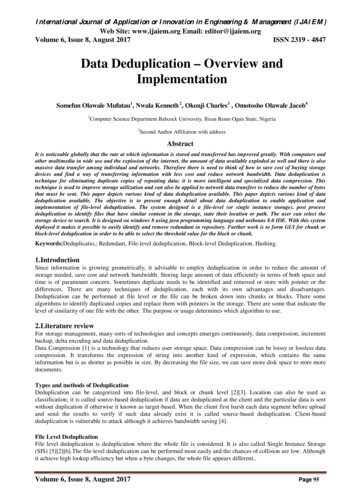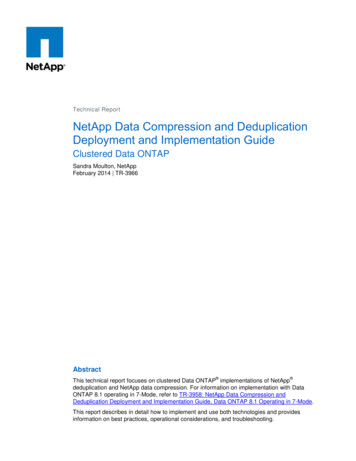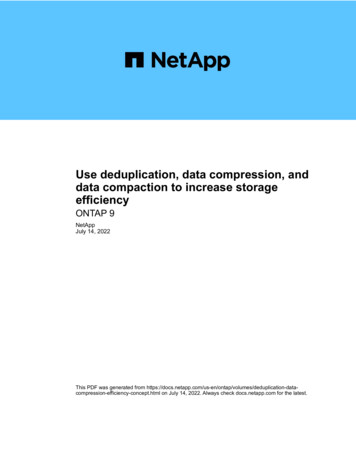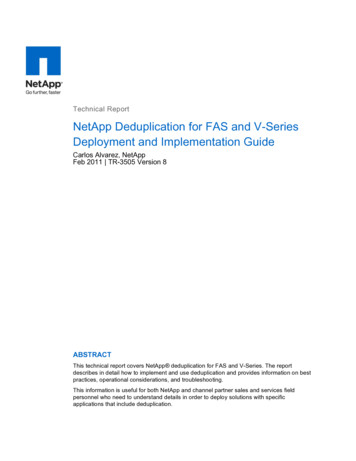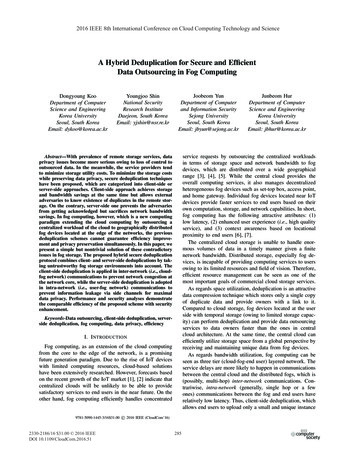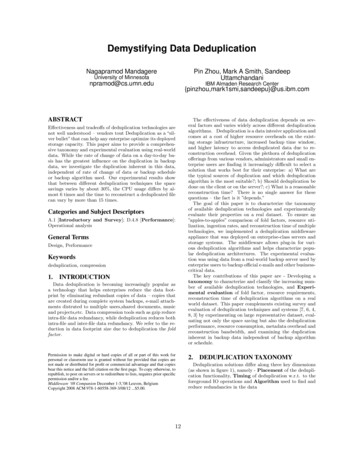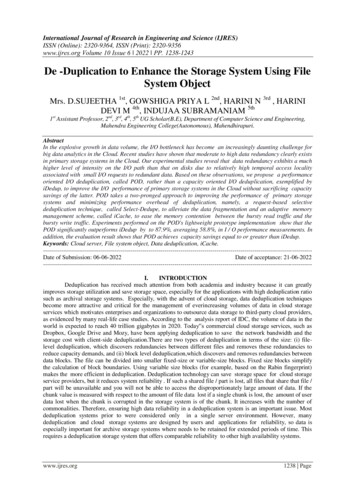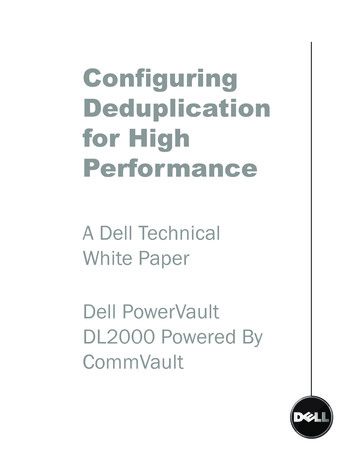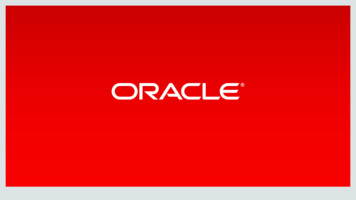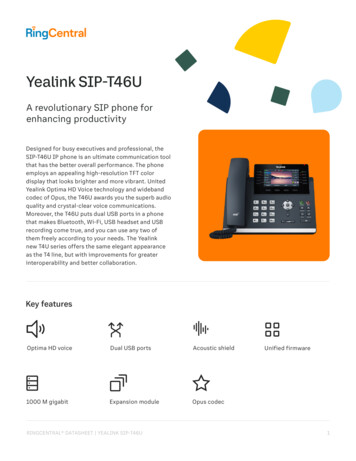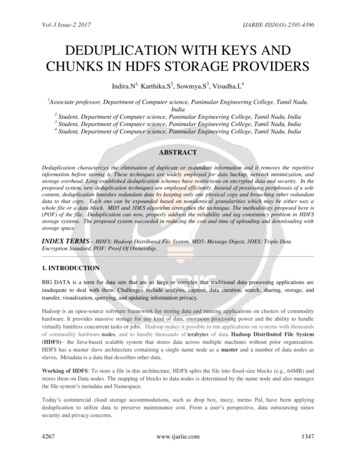
Transcription
Vol-3 Issue-2 2017IJARIIE-ISSN(O)-2395-4396DEDUPLICATION WITH KEYS ANDCHUNKS IN HDFS STORAGE PROVIDERSIndira.N1, Karthika.S2, Sowmya.S3, Visudha.L41Associate professor, Department of Computer science, Panimalar Engineering College, Tamil Nadu,India2Student, Department of Computer science, Panimalar Engineering College, Tamil Nadu, India3Student, Department of Computer science, Panimalar Engineering College, Tamil Nadu, India4Student, Department of Computer science, Panimalar Engineering College, Tamil Nadu, IndiaABSTRACTDeduplication characterizes the elimination of duplicate or redundant information and it removes the repetitiveinformation before storing it. These techniques are widely employed for data backup, network minimization, andstorage overhead. Long established deduplication schemes have restrictions on encrypted data and security. In theproposed system, new deduplication techniques are employed efficiently. Instead of possessing periphrasis of a solecontent, deduplication banishes redundant data by keeping only one physical copy and broaching other redundantdata to that copy. Each one can be expounded based on nonidentical granularities which may be either way awhole file or a data block. MD5 and 3DES algorithm strengthen the technique. The methodology proposed here is(POF) of the file. Deduplication can now, properly address the reliability and tag consistency problem in HDFSstorage systems. The proposed system succeeded in reducing the cost and time of uploading and downloading withstorage space.INDEX TERMS— HDFS: Hadoop Distributed File System, MD5: Message Digest, 3DES: Triple DataEncryption Standard, POF: Proof Of Ownership.1. INTRODUCTIONBIG DATA is a term for data sets that are so large or complex that traditional data processing applications areinadequate to deal with them. Challenges include analysis, capture, data curation, search, sharing, storage, andtransfer, visualization, querying, and updating information privacy.Hadoop is an open-source software framework for storing data and running applications on clusters of commodityhardware. It provides massive storage for any kind of data, enormous processing power and the ability to handlevirtually limitless concurrent tasks or jobs. Hadoop makes it possible to run applications on systems with thousandsof commodity hardware nodes, and to handle thousands of terabytes of data. Hadoop Distributed File System(HDFS)– the Java-based scalable system that stores data across multiple machines without prior organization.HDFS has a master slave architecture containing a single name node as a master and a number of data nodes asslaves. Metadata is a data that describes other data.Working of HDFS: To store a file in this architecture, HDFS splits the file into fixed-size blocks (e.g., 64MB) andstores them on Data nodes. The mapping of blocks to data nodes is determined by the name node and also managesthe file system’s metadata and Namespace.Today’s commercial cloud storage accommodations, such as drop box, mozy, memo Pal, have been applyingdeduplication to utilize data to preserve maintenance cost. From a user’s perspective, data outsourcing raisessecurity and privacy concerns.4267www.ijariie.com1347
Vol-3 Issue-2 2017IJARIIE-ISSN(O)-2395-4396In this paper we tend to achieve incipient distributed de-duplication systems with higher reliability in which the datachunks are distributed across HDFS storage systems and reliable key management technique is employed for securede-duplication. The proficiency which has been proposed to expunge the shortcomings of the existing deduplicationconcept is convergent encryption, proof of ownership and efficient key management schemes. Therefore thesubstrate deduplication is performed at both file level and block level and we define a HDFS Master machine toenhance the security and storage.To summarize our contributions: Offers an efficient key management solution through the metadata manager.Preserves confidentiality and privacy against malicious storage providers by encrypting the chunks whichare at random storage.Assures both block-level and file-level deduplication.Define typical operations such as editing and deleting of contents.2. RELATED WORK“CloudDedup: secure deduplication with encrypted data for cloud storage “, Pasquale puzio1, Refik Molva2,Melek onen3 [1], plans a framework which accomplishes secrecy and empowers block level deduplication in themeantime. Our framework is based on top of convergent encryption. We demonstrated that it merits performingblock level deduplication rather than file level deduplication. Evades COF and LRI attacks (confirmation of record)(take in the rest of the data). “A Hybrid cloud approach for secure authorized de-duplication”, Jagadish1,Dr.Suvurna Nandyal2 [2], Address the issue of authorized data duplication. Deals with hybrid cloud and thuspossess the benefits of both the public and private cloud. The copy check tokens of documents are created by theprivate cloud server with private keys. “Secure and constant cost public cloud storage auditing with Deduplication”, Jiawel yuan1, Shucheng yu2 [3], Outperforms existing POR and PDP schemes with deduplication.Consistent cost scheme that accomplishes secure public data integrity. “Provable ownership of file in deduplication cloud storage”, Chao yang1, jian ren2, jianfeng ma3 [4], proposes a plan that can produce provableownership for file [POF] and keep up a high discovery likelihood of the client misbehavior. Very proficient inlessening the weight of the client. “Secure Deduplication with Efficient and Reliable Convergent KeyManagement” J.Li1, X.Chen2, M.Li3, J.Li4, P.Lee5, and W.Lou6, [5] proposed dekey, a productive and solidmanagement conspire for secure deduplication. They execute dekey utilizing the ramp secret sharing plan and showthat it incurs little encoding/decoding overhead contrasted with the system transmission overhead in the generaltransfer/download operations. “A Secure data deduplication scheme for cloud storage”, J.Stanek 1, A.Sorniotti2,E.Androulaki3, and L.Kenel4 [6], private users outsource their data to cloud storage providers. Late data ruptureepisodes make end-to-end encryption an undeniably noticeable necessity. Data deduplication can be viable forpopular data, while semantically secure encryption ensures disagreeable content. “A reverse deduplication storagesystem optimized for reads to latest backups”, C.Ng and P.Lee. Revdedup [7] had present RevDedup, a deduplication system designed for VM disk image backup in virtualization environments. RevDedup has severaldesign goals: high storage efficiency, low memory usage, high backup performance, and high restore performancefor latest backups. They extensively evaluate our RevDedup prototype using different workloads and validate ourdesign goals. “Secure Data Deduplication with Dynamic Ownership Management in Cloud Storage”,Junbeom Hur1, Dongyoung Koo2, Youngjoo Shin3, and Kyungtae Kang4 [8], a novel server-side deduplicationscheme for encrypted data. It permits the cloud server to control access to outsourced data even notwithstandingwhen the proprietorship changes progressively by misusing randomized convergent encryption and securepossession gather key distribution. This counteracts data leakage exclusively to disavowed clients despite the factthat they beforehand possessed that information, additionally to a legitimate yet inquisitive distributed storageserver. “Enhanced Dynamic Whole File De-Duplication (DWFD) for Space Optimization in Private CloudStorage Backup”, M. Shyamala Devi1, V. Vimal Khanna2, A. Naveen Bhalaji3 [9], provides dynamic space4267www.ijariie.com1348
Vol-3 Issue-2 2017IJARIIE-ISSN(O)-2395-4396optimization in private cloud storage backup as well as increase the throughput and de-duplicationefficiency.“Deduplication on Encrypted big data in cloud”, Zhen yan1, Wenxiu Ding2 and Robert.H.Deng3[10], De-duplicate encrypted data stored in cloud based on proxy re- encryption, Avoids encrypting of data whileuploading thus saves bandwidth. Over came the brute force attack.3. EXISTING METHODOLOGYExisting systems have only been studied in a single-server setting [10] , [8]. De-duplication systems and Storagesystems are predetermined by users and applications for higher reliability, especially in archival storage. Diverseclients may have similar information duplicates they should have their own arrangement of focalized keys so that nodifferent clients can get to their documents. In particular, every client must affiliate an encoded convergent key witheach block of its outsourced scrambled information duplicates, in order to later re-establish the information copies[1]. As an outcome the quantity of merged keys being presented directly scales with the number of blocks being putaway. The gauge approach is untrustworthy, as it requires every client to dedicatedly ensure his own particularmaster key.4. PROBLEMS IN THE EXISTING SYSTEMThe existing techniques were built over Single server system. Deduplication is not scalable with the enormousincreasing cloud users. Efficient key management scheme was not maintained so as to manage the convergent keysgenerated with the increasing number of cloud users.Cost increases to the storage of content as well as for the keysstorage. Security breaches as the technique is approached over a single server setting, if once hacked the info can becollected at a common server.5. PROPOSED WORKTo empower the de-duplication in distributed storage of data crosswise over HDFS, the idea of deduplication is accomplished by the method of Proof of Ownership. The convergent keys are outsourced to slavemachines safely and uphold both file and block level de-duplication. We bear confidentiality and security byimplementing Triple DES algorithm. Cost efficiency is accomplished as numerous clients of the same data is quiterecently alluded and not recently included. Erasing/Editing contents of shared document of a various client willpermit erasing/altering the convergent key references and not the soul content in HDFS file storage. In the event thata FILE is found to have copy duplicates, the soul content in the hdfs master has recently alluded to the slavemachines.The proposed work has mainly four phases, MASTERING FILE TO HDFS STORAGE PROVIDER;SEGMENTING THE FILE CHOSEN; KEY SHARING; HASH VALUE BASED DECRYPTION5.1 MASTERING FILE TO HDFS STORAGE PROVIDERIn this module a user is an entity who wants to outsource data storage to the HDFS Storage and access the data later.User registers to the HDFS storage with necessary information and login the page for uploading the file. Userchooses the file and uploads to Storage where the HDFS store the file in rapid storage system and file leveldeduplication is checked. We tag the file by using md5 message-digest algorithm which is a cryptographic hashfunction that produces the required hash value.4267www.ijariie.com1349
Vol-3 Issue-2 2017IJARIIE-ISSN(O)-2395-4396Fig 1: initial phase5.2 SEGMENTING THE FILE CHOSENAs the file is being uploaded to the cloud, the next step would be the segmentation of the file chosen and taggeneration. Hence we produce united keys for each block split, to check block level de-duplication. Here we give afilename and password for file approval in future. The blocks are encrypted by Triple Data Encryption Standard(3DES) algorithm. The plain content is encoded triple times with convergent key, thus while decoding the originalcontent it likewise requires a similar key to decode it again with the same convergent keys.Fig 2: segmentation and tag generation of file5.3 KEY SHARINGAfter encryption the convergent keys are safely imparted with slave machines supplier to Key Managementmachines. Key administration slave checks copy duplicates of focalized (convergent) keys in KMCSP. KeyManagement slave keeps up Comma Separated Values (CSV) document to check evidence of verification and storekeys safely. The diverse clients who share the common keys are alluded by their own particular proprietorship(proof of ownership). If User request for deletion, certainly he need to prove proof of ownership to delete owncontents.5.4. HASH VALUE BASED DECRYPTIONThe last module where the client asks for downloading their soul content that is stored in HDFS storage. Thisdownload request needs proper possession check of the document and affirms existing tag of the user which is as ofnow generated by md5 algorithm. The proprietorship is confirmed with the unique tag. After verification, theoriginal content is decrypted by requesting the Distributed HDFS storage. Where HDFS storage request the keymanagement slave for keys to decrypt and finally the original content is downloaded. The delete request will deleteonly the reference of the content shared by the common users and not the whole content.4267www.ijariie.com1350
Vol-3 Issue-2 2017IJARIIE-ISSN(O)-2395-4396Fig 3: final phase- decrypting the file6. OVERALL ARCHITECTUREFig -4 Architecture diagram of the proposed systemFig -4 gives an out picture of the proposed system. The cloud user uploads the original file, at the initial phase a tagis generated to the entire file using MD5 algorithm. The convergent keys are generated respectively and the file getsuploaded to the HDFS storage as cipher text. As the tag is generated for each file, the de-duplication check(bothblock level and file level) is done using CSV. If a copy is found for the file uploaded, only the reference is generatedwith the soul content. The references are stored into the slave machines, and the hdfs master will have the soulcontent as cipher text. As on with the download request, PROOF OF VERIFICATION [POF] for each authenticateduser is verified in the HDFS storage. The HDFS storage supports back with the cipher text to the authorized user.With the keys generated the cipher text is decrypted and original file is given to the cloud user. Regarding the deleteand edit option, only the references are deleted and edited and not the soul content.4267www.ijariie.com1351
Vol-3 Issue-2 2017IJARIIE-ISSN(O)-2395-43967. FLOW DIAGRAM OF PROPOSED ESYESCLOUDPREUPLOADDOWNLOADCHOOSE DATAENTER USER’SKEYTAG GENERATION[MD5]DECRYPTDOWNLOAD DATACHECKDADEDUPLICATIONYESNOENCRYPT THEDATA [3DES]PREGENERATEREFERENCE WITHSOUL CONTENTSTORE ON HDFS8. RESULTS AND DISCUSSIONSOur system was tested for efficiency in terms of computation and communication cost requirements and itwas found that our proposed method incurred very less computation and communication costs. Further, theuploading of cloud user’s file to the HDFS storage was encrypted using the 3DES method which required very lesscost for setting up and is considered the most efficient for our application since any attempt to hack the system isvery expensive and is thus avoided. The Proof of ownership scheme was also reliable to authenticate each clouduser, and the tag generation of each file was generated using MD5 algorithm. Thus our system is found to radiatehigh performance and efficiency.4267www.ijariie.com1352
Vol-3 Issue-2 2017IJARIIE-ISSN(O)-2395-43969. CONCLUSIONIn this project, the new conveyed de duplication frame works with file level and fine grained blocked level datadeduplication, support with higher unwavering quality in which the data lumps are appropriately aslant over HDFSstorage, and reliable key administration is enforced in secure deduplication and the security of labels consistencyand honesty were accomplished.10. REFERENCES[1] Pasquale puzio1, Refik Molva2, Melek onen3: Cloud Dedup - secure deduplication with encrypted data forcloud storage. In IEEE 5th International Conference, Dec 2013.[2] Jagadish1, Dr.Suvurna Nandyal2 : A Hybrid cloud approach for secure authorized de-duplication.Published in International Journal of Science and Research (IJSR), 2013.[3] Jiawel Yuan1, Shucheng yu2: Secure and constant cost public cloud storage auditing with Deduplication . InIEEE Conference, published in communication and network security, 2013.[4] Chao Yang1, Jianren2, Jianfengma3: Provable ownership of file in deduplication cloud storage. Published inGlobal Communication Conference, Dec 2013.[5] J.Li1, X.Chen2, M.Li3, J.Li4, P.Lee5, and W.Lou6: Secure Deduplication with Efficient and ReliableConvergent Key Management. In IEEE Transactions on parallel and Distributed systems, 2013.[6] J.Stanek1, A.Sorniotti2, E.Androulaki3, and L.Kenel4: A Secure data deduplication scheme for cloud storage.In Technical Report, 2013.[7] C.Ng and P.Lee. Revdedup: A reverse deduplication storage system optimized for reads to latest backups.In Proc of APSYS, Apr 2013.[8] Junbeom Hur1, Dongyoung Koo2, Youngjoo Shin3, and Kyungtae Kang4: “Secure Data Deduplication withDynamic Ownership Management in Cloud Storage”, In IEEE Transactions on Knowledge and DataEngineering, June 2016.[9] M. Shyamala Devi1, V. Vimal Khanna2, A. Naveen Bhalaji3: “Enhanced Dynamic Whole File De-Duplication(DWFD) for Space Optimization in Private Cloud Storage Backup”, in International Journal of MachineLearning and Computing, April 2014[10] Zhen Yan1, Wenxiu Ding2, Robert.H.Deng3: De-duplication on encrypted big data in cloud . In IEEEtransaction on big data Vol.2, No.2, April – June 2016.4267www.ijariie.com1353
storage. Security breaches as the technique is approached over a single server setting, if once hacked the info can be collected at a common server. 5. PROPOSED WORK To empower the de-duplication in distributed storage of data crosswise over HDFS, the idea of de-duplication is accomplished by the method of Proof of Ownership.
